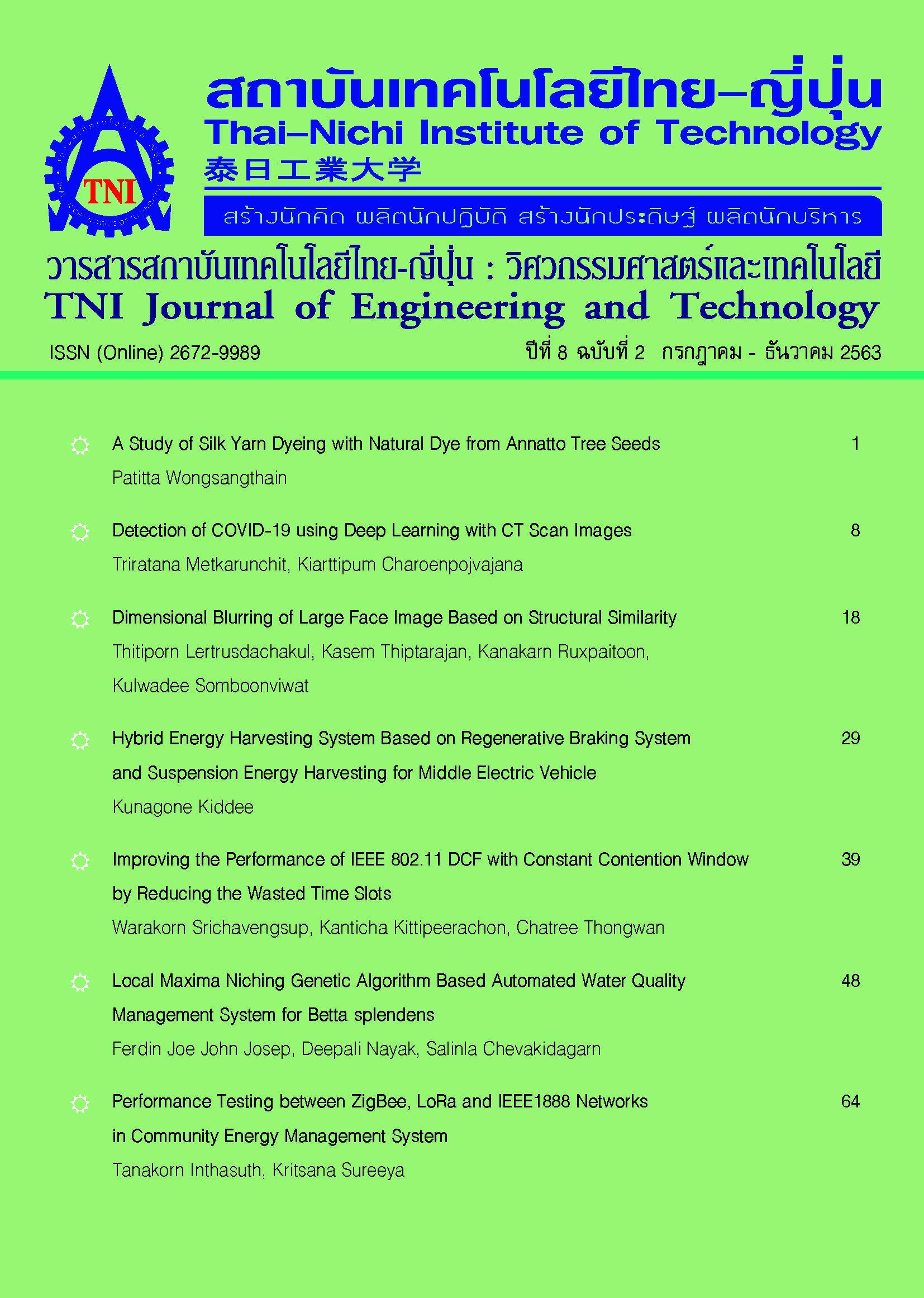Detection of COVID-19 using Deep Learning with CT Scan Images
Main Article Content
Abstract
The demand of testing the potential infected patient of “new corona virus” or COVID-19 has been enormously increased as the virus is still continuously and immensely spread in many countries. The popular method of testing is to analyze the genetic material of the virus with reverse transcription - polymerase chain reaction (RT-PCR). Recently, the chest x-rays have been introduced to diagnose the infection as it is considered to be easier and crucial method in this circumstance, especially when combine with a deep learning that can recognize and detect the abnormality of lung parenchyma, in which considered to be the signature of COVID-19 effectively. The purpose of this article is to adapt the mask region-based convolutional neural networks (Mask RCNN) to segment the regions that had been affected by the virus by using computed tomography (CT) scan on the chest. The prediction of the tissues regions that have been damaged will help the medical team to classify if the patients are in ‘mild’ or ‘danger’ situation easier. From the model test result processed on google cloud platform, this model F1 scores equivalent to 89% and has the average of speed inference at 9.71 second.
Article Details
Article Accepting Policy
The editorial board of Thai-Nichi Institute of Technology is pleased to receive articles from lecturers and experts in the fields of engineering and technology written in Thai or English. The academic work submitted for publication must not be published in any other publication before and must not be under consideration of other journal submissions. Therefore, those interested in participating in the dissemination of work and knowledge can submit their article to the editorial board for further submission to the screening committee to consider publishing in the journal. The articles that can be published include solely research articles. Interested persons can prepare their articles by reviewing recommendations for article authors.
Copyright infringement is solely the responsibility of the author(s) of the article. Articles that have been published must be screened and reviewed for quality from qualified experts approved by the editorial board.
The text that appears within each article published in this research journal is a personal opinion of each author, nothing related to Thai-Nichi Institute of Technology, and other faculty members in the institution in any way. Responsibilities and accuracy for the content of each article are owned by each author. If there is any mistake, each author will be responsible for his/her own article(s).
The editorial board reserves the right not to bring any content, views or comments of articles in the Journal of Thai-Nichi Institute of Technology to publish before receiving permission from the authorized author(s) in writing. The published work is the copyright of the Journal of Thai-Nichi Institute of Technology.
References
World Health Organization, “WHO coronavirus disease (COVID-19) dashboard,” Accessed: Nov. 10, 2020. [Online]. Available: https://covid19.who.int
F. Pan, T. Ye, P. Sun, S. Gui, B. Liang, L. Li, D. Zheng, J. Wang, R. L. Hesketh, L. Yang, and C. Zheng, “Time course of lung changes at chest CT during recovery from coronavirus disease 2019 (COVID-19),” Radiology, vol. 295, no.3, pp. 715–721, 2020.
S. Basu, S. Mitra, and N. Saha, “Deep learning for screening COVID-19 using chest X-ray Images,” 2020. [Online]. Available: arXiv:2004.10507.
S. Latif, J. Qadir, S. Farooq, and M. A. Imran, “How 5G wireless (and concomitant technologies) will revolutionize healthcare?,” Future Internet, vol. 9, no. 4, pp. 1-24, 2017.
Y. Wang, C. Dong, Y. Hu, C. Li, Q. Ren, X. Zhang, H. Shi, and M. Zhou, “Temporal changes of CT findings in 90 patients with COVID-19 pneumonia:A longitudinal study,” Radiology, vol. 296, no. 2, pp. E55-E64, Mar, 2020.
J. L. He, L. Luo, Z. D. Luo, J. X. Lyu, M. Y. Ng, X. P. Shen, and Z. Wen, “Diagnostic performance between CT and initial real-time RT-PCR for clinically suspected 2019 coronavirus disease (COVID-19) patients outside Wuhan, China,” Respiratory Medicine, vol. 168, pp. 1-5, Apr. 2020.
S. C. Shelmerdine, J. Lovrenski, P. C. Domínguez, and S. Toso, “Coronavirus disease 2019 (COVID-19) in children: A systematic review of imaging findings,” Pediatric Radiology, vol. 50, no. 9, pp. 1217–1230, Jun, 2020.
G. Maguolo and L. Nanni, “A critic evaluation of methods for COVID-19 automatic detection from x-ray images,” 2020. [Online]. Available: arXiv:2004.12823.
F. Shan, Y. Gao, J. Wang, W. Shi, N. Shi, M. Han, Z. Xue, and Y. Shi, “Lung infection quantification of COVID-19 in CT images with deep learning,” 2020. [Online]. Available: arXiv:2003.04655.
K. He, G. Gkioxari, P. Dollár, and R. Girshick, “Mask R-CNN,” 2018. [Online]. Available: arXiv:1703.06870.
M. Aleem, R. Raj, and A. Khan, “Comparative performance analysis of the ResNet backbones of mask RCNN to segment the signs of COVID-19 in chest CT scans,” 2020. [Online]. Available: arXiv:2008.09713.
J. P. Cohen, P. Morrison, L. Dao, K. Roth, T. Q. Duong, and M. Ghassemi, “COVID-19 image data collection: Prospective predictions are the future,” 2020. [Online]. Available: arXiv:2006.11988.
COVID-19 Database, Società Italiana di Radiologia, Nov. 2020. [Online]. Available: https://www.sirm.org/category/senza-categoria/covid-19
A. Dutta, A. Gupta, and A. Zisserman. VGG Image Annotator. (2020). Access: Nov. 10, 2020. [Online]. Available: http://www.robots.ox.ac.uk/~vgg/software/via


